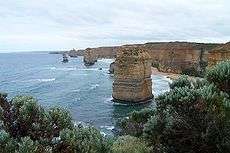Victoria (Australia)
| Victoria | |||||
|---|---|---|---|---|---|
| |||||
| Slogan or nickname |
The Garden State On The Move The Place to Be The Education State | ||||
| Motto(s) | Peace and Prosperity | ||||
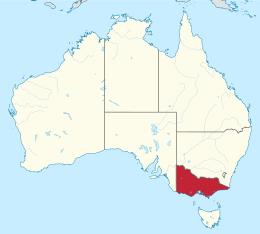 Other Australian states and territories | |||||
| Coordinates | 37°S 144°E / 37°S 144°ECoordinates: 37°S 144°E / 37°S 144°E | ||||
| Capital city | Melbourne | ||||
| Demonym | Victorian | ||||
| Government | Constitutional monarchy | ||||
| • Governor | Linda Dessau | ||||
| • Premier | Daniel Andrews (ALP) | ||||
| Australian state | |||||
| • British Colony established | 1851 | ||||
| • Responsible government | 1857 | ||||
| • Federation | 1901 | ||||
| • Australia Act | 3 March 1986 | ||||
| Area | |||||
| • Total |
237,659 km² (6th) 91,761 sq mi | ||||
| • Land |
227,436 km² 87,814 sq mi | ||||
| • Water |
10,213 km² (4.3%) 3,943 sq mi | ||||
| Population (Mar 2018)[1] | |||||
| • Population | 6,430,000 (2nd) | ||||
| • Density |
28.27/km² (2nd) 73.2 /sq mi | ||||
| Elevation | |||||
| • Highest point |
Mount Bogong 1,986 m (6,516 ft) | ||||
| Gross state product (2014–15) | |||||
| • Product ($m) | $370,504[2] (2nd) | ||||
| • Product per capita | $54,774 (6th) | ||||
| Time zone(s) |
UTC+10 (AEST) UTC+11 (AEDT) | ||||
| Federal representation | |||||
| • House seats | 37/150 | ||||
| • Senate seats | 12/76 | ||||
| Abbreviations | |||||
| • Postal | VIC | ||||
| • ISO 3166-2 | AU-VIC | ||||
| Emblems | |||||
| • Floral | Pink heath[3] | ||||
| • Animal | Leadbeater's possum | ||||
| • Bird | Helmeted honeyeater | ||||
| • Fish | Weedy seadragon | ||||
| • Mineral or gemstone | Gold[4] | ||||
| • Colours | Navy blue and silver[5] | ||||
| Website |
www | ||||
Victoria (abbreviated as Vic) is a state in south-eastern Australia. Victoria is Australia's most densely populated state and its second-most populous state overall. Most of its population lives concentrated in the area surrounding Port Phillip Bay, which includes the metropolitan area of its state capital and largest city, Melbourne, Australia's second-largest city. Geographically the smallest state on the Australian mainland, Victoria is bordered by Bass Strait and Tasmania to the south,[note 1] New South Wales to the north, the Tasman Sea to the east, and South Australia to the west.
The area that is now known as Victoria is the home of many Aboriginal people groups, including the Boon wurrung, the Bratauolung, the Djadjawurrung, the Gunai, the Gunditjmara, the Taungurong, the Wathaurong, the Wurundjeri, and the Yorta Yorta. There were more than 30 Aboriginal languages spoken in the area prior to the European settlement of Australia. The Kulin nation is an alliance of five Aboriginal nations which makes up much of the central part of the state.[6]
With Great Britain having claimed the entire Australian continent east of the 135th meridian east in 1788, Victoria formed part of the wider colony of New South Wales. The first European settlement in the area occurred in 1803 at Sullivan Bay, and much of what is now Victoria was included in 1836 in the Port Phillip District, an administrative division of New South Wales. Named in honour of Queen Victoria, who signed the division's separation from New South Wales, the colony was officially established in 1851 and achieved self government in 1855.[7] The Victorian gold rush in the 1850s and 1860s significantly increased both the population and wealth of the colony, and by the time of the Federation of Australia in 1901, Melbourne had become the largest city and leading financial centre in Australasia. Melbourne served as federal capital of Australia until the construction of Canberra in 1927, with the Federal Parliament meeting in Melbourne's Parliament House and all principal offices of the federal government being based in Melbourne.
Politically, Victoria has 37 seats in the Australian House of Representatives and 12 seats in the Australian Senate. At state level, the Parliament of Victoria consists of the Legislative Assembly (the lower house) and the Legislative Council (the upper house). The Labor Party led Daniel Andrews as premier has governed Victoria since 2014. The personal representative of the Queen of Australia in the state is the Governor of Victoria, currently Linda Dessau (in office since 2015). Victoria is divided into 79 municipal districts, including 33 cities, although a number of unincorporated areas still exist, which the state administers directly.
The economy of Victoria is highly diversified, with service sectors including financial and property services, health, education, wholesale, retail, hospitality and manufacturing constitute the majority of employment. Victoria's total gross state product (GSP) ranks second in Australia, although Victoria ranks fourth in terms of GSP per capita because of its limited mining activity. Culturally, Melbourne hosts a number of museums, art galleries, and theatres, and is also described as the world's sporting capital.[8][9] The Melbourne Cricket Ground, the largest stadium in Australia and the Southern Hemisphere, hosted the 1956 Summer Olympics and the 2006 Commonwealth Games. The ground is also considered the "spiritual home" of Australian cricket and Australian rules football,[10] and hosts the grand final of the Australian Football League (AFL) each year, drawing crowds of approximately 100,000. Victoria has eight public universities, with the oldest, the University of Melbourne, dating from 1853.
History
| Victoria Colony | |||||
| British Crown Colony | |||||
| |||||
.svg.png) | |||||
| Government | Self-governing colony | ||||
| Monarch | |||||
| • | 1851–1901 | Victoria | |||
| Governor | |||||
| • | 1851–1854 | Charles La Trobe (first) | |||
| • | 1895–1900 | Thomas Brassey (last) | |||
| History | |||||
| • | independence from the New South Wales colony | 1851 | |||
| • | Federation of Australia | 1901 | |||
European colonisation
Victoria, like Queensland, was named after Queen Victoria, who had been on the British throne for 14 years when the colony was established in 1851.[11]
After the founding of the colony of New South Wales in 1788, Australia was divided into an eastern half named New South Wales and a western half named New Holland, under the administration of the colonial government in Sydney. The first British settlement in the area later known as Victoria was established in October 1803 under Lieutenant-Governor David Collins at Sullivan Bay on Port Phillip. It consisted of 402 people (five government officials, nine officers of marines, two drummers, and 39 privates, five soldiers' wives and a child, 307 convicts, 17 convicts' wives, and seven children).[12] They had been sent from England in HMS Calcutta under the command of Captain Daniel Woodriff, principally out of fear that the French, who had been exploring the area, might establish their own settlement and thereby challenge British rights to the continent.
In 1826, Colonel Stewart, Captain Samuel Wright, and Lieutenant Burchell were sent in HMS Fly (Captain Wetherall) and the brigs Dragon and Amity, took a number of convicts and a small force composed of detachments of the 3rd and 93rd regiments. The expedition landed at Settlement Point (now Corinella), on the eastern side of Western Port Bay, which was the headquarters until the abandonment of Western Port at the insistence of Governor Darling about 12 months afterwards.[13][14]
Victoria's next settlement was at Portland, on the south west coast of what is now Victoria. Edward Henty settled Portland Bay in 1834.[15]
Melbourne was founded in 1835 by John Batman, who set up a base in Indented Head, and John Pascoe Fawkner. From settlement, the region around Melbourne was known as the Port Phillip District, a separately administered part of New South Wales. Shortly after, the site now known as Geelong was surveyed by Assistant Surveyor W. H. Smythe, three weeks after Melbourne. And in 1838, Geelong was officially declared a town, despite earlier European settlements dating back to 1826.
Creation of separate colony of Victoria
On 1 July 1851, writs were issued for the election of the first Victorian Legislative Council, and the absolute independence of Victoria from New South Wales was established proclaiming a new Colony of Victoria.[16] Days later, still in 1851 gold was discovered near Ballarat, and subsequently at Bendigo. Later discoveries occurred at many sites across Victoria. This triggered one of the largest gold rushes the world has ever seen. The colony grew rapidly in both population and economic power. In 10 years, the population of Victoria increased sevenfold from 76,000 to 540,000. All sorts of gold records were produced, including the "richest shallow alluvial goldfield in the world" and the largest gold nugget. Victoria produced in the decade 1851–1860 20 million ounces of gold, one-third of the world's output.
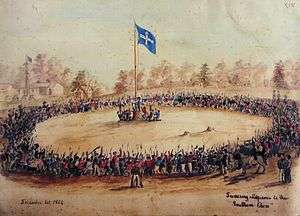
Immigrants arrived from all over the world to search for gold, especially from Ireland and China.[17] By 1857, 26,000 Chinese miners worked in Victoria, and their legacy is particularly strong in Bendigo and its environs. Although some racism was directed at them,[18] the level of anti-Chinese violence was not as great as was seen at the Lambing Flat riots in New South Wales. However, a riot at Buckland Valley near Bright occurred in 1857. Conditions on the gold fields were cramped and unsanitary; an outbreak of typhoid at Buckland Valley in 1854 killed over 1,000 miners.
In 1854 at Ballarat, an armed rebellion against the government of Victoria was made by miners protesting against mining taxes (the "Eureka Stockade"). This was crushed by British troops, but the discontents prompted colonial authorities to reform the administration (particularly reducing the hated mining licence fees) and extend the franchise. Within a short time, the Imperial Parliament granted Victoria responsible government with the passage of the Colony of Victoria Act 1855. Some of the leaders of the Eureka rebellion went on to become members of the Victorian Parliament.
The first foreign military action by the colony of Victoria was to send troops and a warship to New Zealand as part of the Māori Wars. Troops from New South Wales had previously participated in the Crimean War.
In 1901, Victoria became a state in the Commonwealth of Australia. As a result of the gold rush, Melbourne had by then become the financial centre of Australia and New Zealand. Between 1901 and 1927, Melbourne was the capital of Australia while Canberra was under construction. It was also the largest city in Australia at the time..
Government

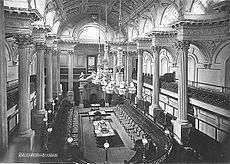
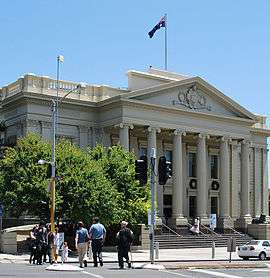
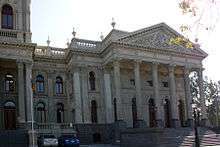
Parliament
Victoria has a parliamentary form of government based on the Westminster System. Legislative power resides in the Parliament consisting of the Governor (the representative of the Queen), the executive (the Government), and two legislative chambers. The Parliament of Victoria consists of the lower house Legislative Assembly, the upper house Legislative Council and the Queen of Australia.
Eighty-eight members of the Legislative Assembly are elected to four-year terms from single-member electorates.
In November 2006, the Victorian Legislative Council elections were held under a new multi-member proportional representation system. The State of Victoria was divided into eight electorates with each electorate represented by five representatives elected by Single Transferable Vote. The total number of upper house members was reduced from 44 to 40 and their term of office is now the same as the lower house members—four years. Elections for the Victorian Parliament are now fixed and occur in November every four years. Prior to the 2006 election, the Legislative Council consisted of 44 members elected to eight-year terms from 22 two-member electorates.
| Party | Legislative Assembly | Legislative Council |
|---|---|---|
| Labor | 47 | 14 |
| Liberal | 30 | 14 |
| National | 8 | 2 |
| Greens | 2 | 5 |
| Others | 1 | 5 |
Premier and cabinet
The Premier of Victoria is the leader of the political party or coalition with the most seats in the Legislative Assembly. The Premier is the public face of government and, with cabinet, sets the legislative and political agenda. Cabinet consists of representatives elected to either house of parliament. It is responsible for managing areas of government that are not exclusively the Commonwealth's, by the Australian Constitution, such as education, health and law enforcement. The current Premier of Victoria is Daniel Andrews.
Governor
Executive authority is vested in the Governor of Victoria who represents and is appointed by Queen Elizabeth II. The post is usually filled by a retired prominent Victorian. The governor acts on the advice of the premier and cabinet. The current Governor of Victoria is Linda Dessau.
Constitution
Victoria has a written constitution enacted in 1975,[19] but based on the 1855 colonial constitution, passed by the United Kingdom Parliament as the Victoria Constitution Act 1855, which establishes the Parliament as the state's law-making body for matters coming under state responsibility. The Victorian Constitution can be amended by the Parliament of Victoria, except for certain "entrenched" provisions that require either an absolute majority in both houses, a three-fifths majority in both houses, or the approval of the Victorian people in a referendum, depending on the provision.
Politics
Victorians, and Melburnians in particular, are considered by some analysts to be more progressive than other Australians.[20] The state recorded the highest Yes votes of any state in the republic referendum and same-sex marriage survey. Victorians are said to be "generally socially progressive, supportive of multiculturalism, wary of extremes of any kind".[21]
Premier Daniel Andrews leads the Australian Labor Party that won the November 2014 Victorian state election.
The centre-left Australian Labor Party (ALP), the centre-right Liberal Party of Australia, the rural-based National Party of Australia, and the left-wing environmentalist Australian Greens are Victoria's main political parties. Traditionally, Labor is strongest in Melbourne's working class western and northern suburbs, and the regional cities of Ballarat, Bendigo and Geelong. The Liberals' main support lies in Melbourne's more affluent eastern and outer suburbs, and some rural and regional centres. The Nationals are strongest in Victoria's North Western and Eastern rural regional areas. The Greens, who won their first lower house seats in 2014, are strongest in inner Melbourne.
Federal government
Victorian voters elect 49 representatives to the Parliament of Australia, including 37 members of the House of Representatives and 12 members of the Senate. Since 2013, the ALP has held 19 Victorian house seats, the Liberals 14, the Nationals two, the Greens one, and one held by an Independent. As of 1 July 2014, the Liberals have held three senate seats, the Nationals one, the ALP four, the Greens two, and the Democratic Labor Party one.
Local government
Victoria is incorporated into 79 municipalities for the purposes of local government, including 39 shires, 32 cities, seven rural cities and one borough. Shire and city councils are responsible for functions delegated by the Victorian parliament, such as city planning, road infrastructure and waste management. Council revenue comes mostly from property taxes and government grants.[22]
Demographics
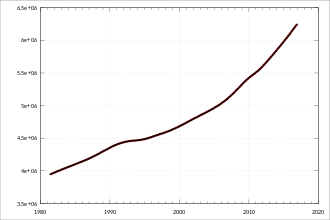
| Population growth estimates for Victoria | |
|---|---|
| 2007 | 5,087,000 |
| 2011 | 5,500,000 |
| 2016 | 6,000,000 |
| 2021 | 6,400,000 |
| 2026 | 6,800,000 |
| 2031 | 7,300,000 |
| Source: Dept of Planning and Community Development | |
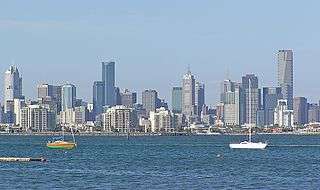
At March 2018 Victoria had a population of 6,430,000.[1] The Australian Bureau of Statistics estimates that the population may well reach 7.2 million by 2050.
Victoria's founding Anglo-Celtic population has been supplemented by successive waves of migrants from southern and eastern Europe, Southeast Asia and, most recently, the Horn of Africa and the Middle East. Victoria's population is ageing in proportion with the average of the remainder of the Australian population.
About 72% of Victorians are Australian-born. This figure falls to around 66% in Melbourne but rises to higher than 95% in some rural areas in the north west of the state. Around two-thirds of Victorians claim Scottish, English or Irish ancestry. Less than 1% of Victorians identify themselves as Aboriginal. The largest groups of people born outside Australia came from the British Isles, China, Italy, Vietnam, Greece and New Zealand.
More than 75% of Victorians live in Melbourne, located in the state's south. The greater Melbourne metropolitan area is home to an estimated 4,850,740 people.[23] Urban centres outside Melbourne include Geelong, Ballarat, Bendigo, Shepparton, Mildura, Warrnambool, Wodonga and the Latrobe Valley.
Victoria is Australia's most urbanised state: nearly 90% of residents living in cities and towns. State Government efforts to decentralise population have included an official campaign run since 2003 to encourage Victorians to settle in regional areas,[24] however Melbourne continues to rapidly outpace these areas in terms of population growth.[25]
Age structure and fertility
The government predicts that nearly a quarter of Victorians will be aged over 60 by 2021. The 2011 census reveals that Australian median age has crept upward from 35 to 37 since 2001, which reflects the population growth peak of 1969–72.[26] In 2011, Victoria recorded a TFR of 1.88, the highest after 1978.[27]
Crime
In 2011–2012 there were 173 homicides.[28]
| 2010 | 2011 | 2012 | 2013 | 2014 | |
|---|---|---|---|---|---|
| Number of offences | 378,082 | 386,061 | 423,555 | 437,409 | 456,381 |
Religion
About 61.1% of Victorians describe themselves as Christian. Roman Catholics form the single largest religious group in the state with 26.7% of the Victorian population, followed by Anglicans and members of the Uniting Church. Buddhism is the state's largest non-Christian religion, with 168,637 members as of the most recent census. Victoria is also home of 152,775 Muslims and 45,150 Jews. Hinduism is the fastest growing religion. Around 20% of Victorians claim no religion. Amongst those who declare a religious affiliation, church attendance is low.[30]
In 2012 the proportion of couples marrying in a church had dropped to 28.2%; the other 71.7% registered their marriage with a civil celebrant.[31]
Education
Primary and secondary
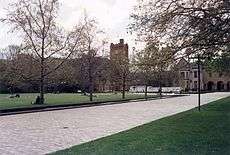

Victoria's state school system dates back to 1872, when the colonial government legislated to make schooling both free and compulsory. The state's public secondary school system began in 1905. Before then, only private secondary schooling was available. Today, a Victorian school education consists of seven years of primary schooling (including one preparatory year) and six years of secondary schooling.
The final years of secondary school are optional for children aged over 17. Victorian children generally begin school at age five or six. On completing secondary school, students earn the Victorian Certificate of Education (VCE) or Victorian Certificate of Applied Learning (VCAL). Students who successfully complete their VCE also receive an ATAR, to determine university admittance.
Victorian schools are either publicly or privately funded. Public schools, also known as state or government schools, are funded and run directly by the Victoria Department of Education . Students do not pay tuition fees, but some extra costs are levied. Private fee-paying schools include parish schools run by the Roman Catholic Church and independent schools similar to British public schools. Independent schools are usually affiliated with Protestant churches. Victoria also has several private Jewish and Islamic primary and secondary schools. Private schools also receive some public funding. All schools must comply with government-set curriculum standards. In addition, Victoria has four government selective schools, Melbourne High School for boys, MacRobertson Girls' High School for girls, the coeducational schools John Monash Science School, Nossal High School and Suzanne Cory High School, and The Victorian College of the Arts Secondary School. Students at these schools are exclusively admitted on the basis of an academic selective entry test.
As of August 2010, Victoria had 1,548 public schools, 489 Catholic schools and 214 independent schools. Just under 540,800 students were enrolled in public schools, and just over 311,800 in private schools. Over 61 per cent of private students attend Catholic schools. More than 462,000 students were enrolled in primary schools and more than 390,000 in secondary schools. Retention rates for the final two years of secondary school were 77 per cent for public school students and 90 per cent for private school students. Victoria has about 63,519 full-time teachers.[32]
Tertiary education
Victoria has nine universities. The first to offer degrees, the University of Melbourne, enrolled its first student in 1855. The largest, Monash University, has an enrolment of over 70,000 students—more than any other Australian university.
The number of students enrolled in Victorian universities was 241,755 at 2004, an increase of 2% on the previous year. International students made up 30% of enrolments and account for the highest percentage of pre-paid university tuition fees. The largest number of enrolments were recorded in the fields of business, administration and economics, with nearly a third of all students, followed by arts, humanities, and social science, with 20% of enrolments.
Victoria has 18 government-run institutions of "technical and further education" (TAFE). The first vocational institution in the state was the Melbourne Mechanics' Institute (established in 1839), which is now the Melbourne Athenaeum. More than 1,000 adult education organisations are registered to provide recognised TAFE programs. In 2004, there were about 480,700 students enrolled in vocational education programs in the state.[33]
Libraries
The State Library of Victoria is the State's research and reference library. It is responsible for collecting and preserving Victoria's documentary heritage and making it available through a range of services and programs. Material in the collection includes books, newspapers, magazines, journals, manuscripts, maps, pictures, objects, sound and video recordings and databases.
In addition, local governments maintain local lending libraries, typically with multiple branches in their respective municipal areas.
Economy
| Victorian production and workers by economic activities | |||
|---|---|---|---|
| Economic sector |
GSP produced[34] |
Number of workers ('000s) |
Percentage of workers |
| Finance, insurance services |
12.8% | 115.5 | 3.8% |
| Professional, technical services |
9.1% | 274.3 | 9.0% |
| Manufacturing | 8.6% | 274.4 | 9.0% |
| Health Care, social services |
8.5% | 390.6 | 12.8% |
| Construction | 7.7% | 255,7 | 6.4% |
| Education | 6.7% | 257.7 | 8.5% |
| Retail Trade | 6.0% | 310.6 | 10.2% |
| Transport Services | 5.7% | 165.4 | 5.4% |
| Wholesale Trade | 5.6% | 113.4 | 3.7% |
| Public Administration |
5.0% | 146.5 | 4.8% |
| Communications and IT |
3.9% | 57.0 | 1.9% |
| Real Estate | 3.7% | 43.6 | 1.4% |
| Administrative services |
3.3% | 119.0 | 3.9% |
| Accommodation and food services |
2.9% | 209.9 | 6.9% |
| Agriculture, forestry and fishing |
2.8% | 86.1 | 2.8% |
| Utilities | 2.4% | 39.4 | 1.3% |
| Mining | 2.0% | 11.0 | 0.4% |
| Arts and recreation |
1.1% | 63.2 | 2.1% |
| Other Services | - | 115.1 | 3.8% |
| Source: Australian Bureau of Statistics. GSP as of June 2016. Employment as of Aug 2016. | |||
The state of Victoria is the second largest economy in Australia after New South Wales, accounting for a quarter of the nation's gross domestic product. The total gross state product (GSP) at current prices for Victoria was A$374 billion in June 2016, with a GSP per capita of A$60,595. The economy grew by 1.0 per cent in the 2015–16 financial year, less than the Australian average of 2.7 per cent.
Finance and insurance is Victoria's largest income producing sector, while the health care and social assistance sector is the state's biggest employer. The shift towards service industries in the preceding decades has seen manufacturing lose its mantle as Victoria's largest employer and income producer.
Agriculture
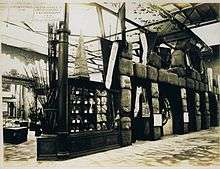
During 2003–04, the gross value of Victorian agricultural production increased by 17% to $8.7 billion. This represented 24% of national agricultural production total gross value. As of 2004, an estimated 32,463 farms occupied around 136,000 square kilometres (52,500 sq mi) of Victorian land. This comprises more than 60% of the state's total land surface. Victorian farms range from small horticultural outfits to large-scale livestock and grain productions. A quarter of farmland is used to grow consumable crops.
More than 26,000 square kilometres (10,000 sq mi) of Victorian farmland are sown for grain, mostly in the state's west. More than 50% of this area is sown for wheat, 33% for barley and 7% for oats. A further 6,000 square kilometres (2,300 sq mi) is sown for hay. In 2003–04, Victorian farmers produced more than 3 million tonnes of wheat and 2 million tonnes of barley. Victorian farms produce nearly 90% of Australian pears and third of apples. It is also a leader in stone fruit production. The main vegetable crops include asparagus, broccoli, carrots, potatoes and tomatoes. Last year, 121,200 tonnes of pears and 270,000 tonnes of tomatoes were produced.
More than 14 million sheep and 5 million lambs graze over 10% of Victorian farms, mostly in the state's north and west. In 2004, nearly 10 million lambs and sheep were slaughtered for local consumption and export. Victoria also exports live sheep to the Middle East for meat and to the rest of the world for breeding. More than 108,000 tonnes of wool clip was also produced—one-fifth of the Australian total.
Victoria is the centre of dairy farming in Australia. It is home to 60% of Australia's 3 million dairy cattle and produces nearly two-thirds of the nation's milk, almost 6.4 billion litres. The state also has 2.4 million beef cattle, with more than 2.2 million cattle and calves slaughtered each year. In 2003–04, Victorian commercial fishing crews and aquaculture industry produced 11,634 tonnes of seafood valued at nearly A$109 million. Blacklipped abalone is the mainstay of the catch, bringing in A$46 million, followed by southern rock lobster worth A$13.7 million. Most abalone and rock lobster is exported to Asia.
Manufacturing
Victoria has a diverse range of manufacturing enterprises and Melbourne is considered Australia's most important industrial city. The post-World War II manufacturing boom was fuelled by international investment; attracted to the state by the availability of cheap land close to the city and inexpensive energy from the Latrobe Valley. Victoria produced 26.4% of total manufacturing output in Australia in 2015–16, behind New South Wales at 32.4%.
Machinery and equipment manufacturing is the state's most valuable manufacturing activity, followed by food and beverage products, petrochemicals and chemicals. Prominent manufacturing plants in the state include the Portland and Point Henry aluminium smelters, owned by Alcoa; oil refineries at Geelong and Altona; a major petrochemical facility at Laverton; and Victorian-based CSL, a global biotechnology company that produces vaccines and plasma products, among others. Victoria also plays an important role in providing goods for the defence industry.
Victoria proportionally relies on manufacturing more than any other state in Australia, constituting 8.6% of total state product; slightly higher than South Australia at 8.0%. However, this proportion has been declining for three decades; in 1990 at the time of the early 1990s recession manufacturing constituted 20.3% of total state output. Manufacturing output peaked in absolute terms in 2008, reaching $28.8 billion and has slowly fallen over the decade to $26.8 billion in 2016 (-0.77% per annum). Since 1990, manufacturing employment has also fallen in both aggregate (367,700 to 274,400 workers) and proportional (17.8% to 9.0%) terms. The strong Australian dollar as a result of the 2000s mining boom, small population and isolation, high wage base and the general shift of manufacturing production towards developing countries have been cited as some of the reasons for this decline.
Historically, Victoria has been a hub for the manufacturing plants of the major car brands Ford, Toyota and Holden; however, closure announcements by all three companies in the 2010s has meant Australia will completely lose their car manufacturing industry by the end of 2017. Holden's announcement occurred in May 2013 following Ford's decision in December the previous year (Ford's Victorian plants, in Broadmeadows and Geelong, closed in October 2016).[35][36] Toyota followed suit in February 2014 with an expected announcement as without Holden or Ford, local supply chains would struggle to create the economics of scale required to supply one manufacturer.[37]
Land
Victoria adopted the Torrens system of land registration with the Real Property Act 1862.[38] The Torrens system did not replace the common law system but applied only to new land grants and to land that has been voluntarily registered under the Act, and its successors. The common law system continues to apply to all other private landholdings. Crown land held in Victoria is managed under the Crown Land (Reserves) Act 1978 and the Land Act 1958.
Mining
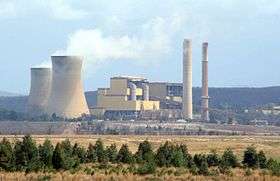
Mining in Victoria contributes around A$6 billion to the gross state product (~2%) but employs less than 1% of workers. The Victorian mining industry is concentrated on energy producing minerals, with brown coal, petroleum and gas accounting for nearly 90% of local production. The oil and gas industries are centred off the coast of Gippsland in the state's east, while brown coal mining and power generation is based in the Latrobe Valley.
In the 2005–06 fiscal year, the average gas production was over 700 million cubic feet (20,000,000 m3) per day (M cuft/d) and represented 18% of the total national gas sales, with demand growing at 2% per year.[39]
In 1985, oil production from the offshore Gippsland Basin peaked to an annual average of 450,000 barrels (72,000 m3) per day. In 2005–2006, the average daily oil production has declined to 83,000 bbl (13,200 m3)/d, but despite the decline Victoria still produces almost 19.5% of crude oil in Australia.[39]
Brown coal is Victoria's leading mineral, with 66 million tonnes mined each year for electricity generation in the Latrobe Valley, Gippsland.[40] The region is home to the world's largest known reserves of brown coal.
Despite being the historic centre of Australia's gold rush, Victoria today contributes a mere 1% of national gold production. Victoria also produces limited amounts of gypsum and kaolin.
Service industry
The service industries sector is the fastest growing component of the Victorian economy. It includes the wide range of activities generally classified as financial and professional services; health care and social assistance, education, transportation, IT and communication services, government services and wholesale and retail trade. Most service industries are located in Melbourne and the state's larger regional centres.
As of 2015–16, service industries employed over three-quarters of Victorian workers and more than three-quarters of the state's GSP. Finance and insurance as a group provide more value-add to the economy than any other economic activity in Victoria while health care and social assistance employ the most workers.
Tourism
.jpg)

Some major tourist destinations in Victoria are:
- The metropolis of Melbourne, particular its inner city suburbs (known also for shopping tourism) and the attractions of the city centre such as Melbourne Zoo, Melbourne Museum, the Melbourne Aquarium and ScienceWorks, tourism precincts such as Melbourne Docklands, Southbank and St Kilda as well as cultural and sporting tourist icons such as Arts Centre Melbourne, the East End Theatre District, the National Gallery of Victoria, the Melbourne Cricket Ground, also known as the MCG, and the Eureka Tower, with the highest observation deck in the Southern Hemisphere, Skydeck 88.
- Victoria has more than 2000 kilometres of coastline with hundreds of beaches.[41]
- The Goldfields region featuring the historic cities of Ballarat, Beechworth, Bendigo, Castlemaine, Maldon and Daylesford.
- Natural attractions, such as The Twelve Apostles, Wilsons Promontory, The Grampians, the fairy penguins (particularly at Phillip Island and St Kilda), the Buchan Caves and the Gippsland Lakes.
- The Dandenong Ranges (in particular the Puffing Billy Railway).
- Healesville Sanctuary, which specialises in local Australian species.
- Towns along the Murray River and Riverina including Echuca and Mildura including waterskiing.
- Geelong and its famous Waterfront, Eastern Beach and Geelong West's Pakington Street
- The Bellarine Peninsula which features vineyards and historic resort towns such as Queenscliff, Drysdale and Portarlington
- The Werribee Mansion and Werribee Open Range Zoo
- The Surf Coast which features famous beaches such as Bells Beach, Torquay and Lorne
- Mornington Peninsula, particularly for its wineries and secluded beaches, Arthur's Seat and the coastal attractions of Portsea and Sorrento.
- Yarra Valley (in particular Healesville Sanctuary and wineries).
- Great Ocean Road, which features The Twelve Apostles, historic towns of Port Fairy and Portland, cliffs and whale watching and resort towns such as Lorne.
- The Victorian Alpine Region, part of the Australian Alps, particularly for skiing
- The Central Victorian Highlands, 'High country' are very well known for winter sports and bushwalking
- Wine regions across the entire state.
Other popular tourism activities are gliding, hang-gliding, hot air ballooning and scuba diving.
Major events that explore cultural diversity, music and sports play a big part in Victoria's tourism. The V8 Supercars and Australian Motorcycle Grand Prix at Phillip Island, the Grand Annual Steeplechase at Warrnambool and the Australian International Airshow at Avalon and numerous local festivals such as the popular Port Fairy Folk Festival, Queenscliff Music Festival, Pako Festa in Geelong West, Bells Beach Surf Classic and the Bright Autumn Festival amongst others.
Geology and geography

Victoria's northern border follows a straight line from Cape Howe to the start of the Murray River and then follows the Murray River as the remainder of the northern border. On the Murray River, the border is the southern bank of the river. This precise definition was not established until 1980, when a ruling by Justice Ninian Stephen of the High Court of Australia settled the question as to which state had jurisdiction in the unlawful death of a man on an island in the middle of the river. The ruling clarified that no part of the watercourse is in Victoria.[42] The border also rests at the southern end of the Great Dividing Range, which stretches along the east coast and terminates west of Ballarat. It is bordered by South Australia to the west and shares Australia's shortest land border with Tasmania. The official border between Victoria and Tasmania is at 39°12' S, which passes through Boundary Islet in the Bass Strait for 85 metres.[43][44][45]
Victoria contains many topographically, geologically and climatically diverse areas, ranging from the wet, temperate climate of Gippsland in the southeast to the snow-covered Victorian alpine areas which rise to almost 2,000 m (6,600 ft), with Mount Bogong the highest peak at 1,986 m (6,516 ft). There are extensive semi-arid plains to the west and northwest. There is an extensive series of river systems in Victoria. Most notable is the Murray River system. Other rivers include: Ovens River, Goulburn River, Patterson River, King River, Campaspe River, Loddon River, Wimmera River, Elgin River, Barwon River, Thomson River, Snowy River, Latrobe River, Yarra River, Maribyrnong River, Mitta River, Hopkins River, Merri River and Kiewa River. The state symbols include the pink heath (state flower), Leadbeater's possum (state animal) and the helmeted honeyeater (state bird).
The state's capital, Melbourne, contains about 70% of the state's population and dominates its economy, media, and culture. For other cities and towns, see list of localities (Victoria) and local government areas of Victoria.
Climate

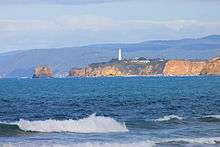
| Average monthly maximum temperatures in Victoria | ||||
|---|---|---|---|---|
| Month | Melbourne °C (°F) |
Mildura °C (°F) | ||
| January | 25.8 (78) | 32.8 (91) | ||
| February | 25.8 (78) | 32.7 (91) | ||
| March | 23.8 (75) | 29.3 (85) | ||
| April | 20.2 (68) | 24.1 (75) | ||
| May | 16.6 (62) | 19.6 (67) | ||
| June | 14.0 (57) | 16.0 (61) | ||
| July | 13.4 (56) | 15.4 (60) | ||
| August | 14.9 (59) | 17.7 (64) | ||
| September | 17.2 (63) | 21.1 (70) | ||
| October | 19.6 (67) | 25.0 (77) | ||
| November | 21.8 (71) | 29.0 (84) | ||
| December | 24.1 (75) | 31.7 (89) | ||
| Source: Bureau of Meteorology | ||||
| Wikimedia Commons has media related to Climate diagrams of Victoria. |
Victoria has a varied climate despite its small size. It ranges from semi-arid temperate with hot summers in the north-west, to temperate and cool along the coast. Victoria's main land feature, the Great Dividing Range, produces a cooler, mountain climate in the centre of the state. Winters along the coast of the state, particularly around Melbourne, are relatively mild (see chart at right).
Victoria's southernmost position on the Australian mainland means it is cooler and wetter than other mainland states and territories. The coastal plain south of the Great Dividing Range has Victoria's mildest climate. Air from the Southern Ocean helps reduce the heat of summer and the cold of winter. Melbourne and other large cities are located in this temperate region. The autumn months of April/May are mild and bring some of Australia's colourful foliage across many parts of the state.
The Mallee and upper Wimmera are Victoria's warmest regions with hot winds blowing from nearby semi-deserts. Average temperatures exceed 32 °C (90 °F) during summer and 15 °C (59 °F) in winter. Except at cool mountain elevations, the inland monthly temperatures are 2–7 °C (4–13 °F) warmer than around Melbourne (see chart). Victoria's highest maximum temperature of 48.8 °C (119.8 °F) was recorded in Hopetoun on 7 February 2009, during the 2009 southeastern Australia heat wave.[46]
The Victorian Alps in the northeast are the coldest part of Victoria. The Alps are part of the Great Dividing Range mountain system extending east–west through the centre of Victoria. Average temperatures are less than 9 °C (48 °F) in winter and below 0 °C (32 °F) in the highest parts of the ranges. The state's lowest minimum temperature of −11.7 °C (10.9 °F) was recorded at Omeo on 15 June 1965, and again at Falls Creek on 3 July 1970.[46] Temperature extremes for the state are listed in the table below:
| Climate data for Victoria | |||||||||||||
|---|---|---|---|---|---|---|---|---|---|---|---|---|---|
| Month | Jan | Feb | Mar | Apr | May | Jun | Jul | Aug | Sep | Oct | Nov | Dec | Year |
| Record high °C (°F) | 47.2 (117) |
48.8 (119.8) |
44.4 (111.9) |
39.3 (102.7) |
32.2 (90) |
25.7 (78.3) |
27.1 (80.8) |
29.9 (85.8) |
37.7 (99.9) |
40.2 (104.4) |
45.8 (114.4) |
46.6 (115.9) |
48.8 (119.8) |
| Record low °C (°F) | −3.9 (25) |
−3.9 (25) |
−4.3 (24.3) |
−8.2 (17.2) |
−8.3 (17.1) |
−11.7 (10.9) |
−11.7 (10.9) |
−10.5 (13.1) |
−9.4 (15.1) |
−8.4 (16.9) |
−6.8 (19.8) |
−5.2 (22.6) |
−11.7 (10.9) |
| Source: Bureau of Meteorology[47] | |||||||||||||
Rainfall
Victoria is the wettest Australian state after Tasmania. Rainfall in Victoria increases from south to the northeast, with higher averages in areas of high altitude. Mean annual rainfall exceeds 1,800 millimetres (71 inches) in some parts of the northeast but is less than 280 mm (11 in) in the Mallee.
Rain is heaviest in the Otway Ranges and Gippsland in southern Victoria and in the mountainous northeast. Snow generally falls only in the mountains and hills in the centre of the state. Rain falls most frequently in winter, but summer precipitation is heavier. Rainfall is most reliable in Gippsland and the Western District, making them both leading farming areas. Victoria's highest recorded daily rainfall was 377.8 mm (14.87 in) at Tidal River in Wilsons Promontory National Park on 23 March 2011.[46]
- Average temperatures and precipitation for Victoria
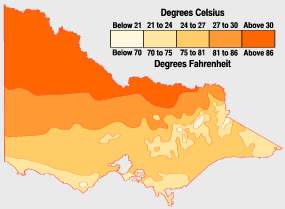 Average January maximum temperatures:
Average January maximum temperatures:
Victoria's north is almost always hotter than coastal and mountainous areas.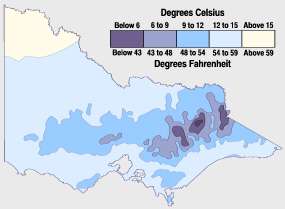 Average July maximum temperatures:
Average July maximum temperatures:
Victoria's hills and ranges are coolest during winter. Snow also falls there. Average yearly precipitation:
Average yearly precipitation:
Victoria's rainfall is concentrated in the mountainous north-east and coast.
Major cities
The following is a list of Victoria's major cities:
Transport
Victoria has the highest population density in any state in Australia, with population centres spread out over most of the state; only the far northwest and the Victorian Alps lack permanent settlement.
The Victorian road network services the population centres, with highways generally radiating from Melbourne and other major cities and rural centres with secondary roads interconnecting the highways to each other. Many of the highways are built to freeway standard ("M" freeways), while most are generally sealed and of reasonable quality.
Rail transport in Victoria is provided by several private and public railway operators who operate over government-owned lines. Major operators include: Metro Trains Melbourne which runs an extensive, electrified, passenger system throughout Melbourne and suburbs; V/Line which is now owned by the Victorian Government, operates a concentrated service to major regional centres, as well as long distance services on other lines; Pacific National, CFCL Australia which operate freight services; Great Southern Rail which operates The Overland Melbourne—Adelaide; and NSW TrainLink which operates XPTs Melbourne—Sydney.
There are also several smaller freight operators and numerous tourist railways operating over lines which were once parts of a state-owned system. Victorian lines mainly use the 1,600 mm (5 ft 3 in) broad gauge. However, the interstate trunk routes, as well as a number of branch lines in the west of the state have been converted to 1,435 mm (4 ft 8 1⁄2 in) standard gauge. Two tourist railways operate over 760 mm (2 ft 6 in) narrow gauge lines, which are the remnants of five formerly government-owned lines which were built in mountainous areas.
Melbourne has the world's largest tram network,[48] currently operated by Yarra Trams. As well as being a popular form of public transport, over the last few decades trams have become one of Melbourne's major tourist attractions. There are also tourist trams operating over portions of the former Ballarat and Bendigo systems. There are also tramway museums at Bylands and Haddon.
Melbourne Airport is the major domestic and international gateway for the state. Avalon Airport is the state's second busiest airport, which complements Essendon and Moorabbin Airports to see the remainder of Melbourne's air traffic. Hamilton Airport, Mildura Airport, Mount Hotham and Portland Airport are the remaining airports with scheduled domestic flights. There are no fewer than 27 other airports in the state with no scheduled flights.
The Port of Melbourne is the largest port for containerised and general cargo in Australia,[49] and is located in Melbourne on the mouth of the Yarra River, which is at the head of Port Phillip. Additional seaports are at Westernport, Geelong, and Portland.
As of October 2013, smoking tobacco is prohibited in the sheltered areas of train stations, and tram and bus stops—between 2012 and 2013, 2002 people were issued with infringement notices. The state government announced a plan in October 2013 to prohibit smoking on all Victorian railway station platforms and raised tram stops.[50]
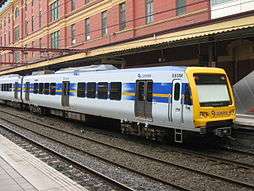
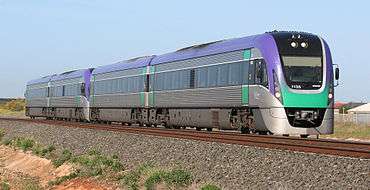
Utilities
Energy
Victoria's major utilities include a collection of brown-coal-fired power stations, particularly in the Latrobe Valley. One of these was the recently decommissioned Hazelwood Power Station, which was number 1 on the worldwide List of least carbon efficient power stations.
Water
Victoria's water infrastructure includes a series of dams and reservoirs, predominantly in Central Victoria, that hold and collect water for much of the state. The water collected is of a very high quality and requires little chlorination treatment, giving the water a taste more like water collected in a rainwater tank. In regional areas however, such as in the west of the state, chlorination levels are much higher.
The Victorian Water Grid consists of a number of new connections and pipelines being built across the State. This allows water to be moved around Victoria to where it is needed most and reduces the impact of localised droughts in an era thought to be influenced by climate change. Major projects already completed as part of the Grid include the Wimmera Mallee Pipeline and the Goldfields Superpipe.[51]
Sport
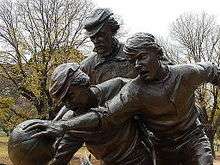
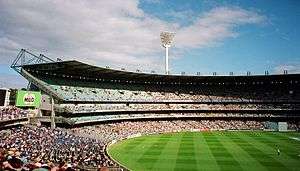
Victoria is the home of Australian rules football, with ten of the eighteen Australian Football League (AFL) clubs based in the state. The AFL Grand Final is traditionally held at the Melbourne Cricket Ground on the last Saturday of September. Victoria's newest public holiday is Grand Final Friday. The holiday is celebrated the day before the AFL Grand Final and was designated in 2015 "to celebrate Australia's national game".
Victoria's cricket team, the Victorian Bushrangers play in the national Sheffield Shield cricket competition. Victoria is represented in the National Rugby League by the Melbourne Storm and in Super Rugby by the Melbourne Rebels. It is represented in the National Basketball League by Melbourne United. It is also represented in soccer by Melbourne Victory and Melbourne City in the A-League.
Melbourne has held the 1956 Summer Olympics, 2006 Commonwealth Games and the FINA World Swimming Championship.
Melbourne is also home to the Australian Open tennis tournament in January each year, the first of the world's four Grand Slam tennis tournaments, and the Australian Formula One Australian Grand Prix in March. It hosted the Australian Masters golf tournament from 1979 to 2015.
Victoria's Bells Beach hosts one of the world's longest-running surfing competition, the Bells Beach SurfClassic, which is part of The ASP World Tour.
Netball is a big part of sport in Victoria. The Melbourne Vixens represent Victoria in the ANZ Championship. Some of the world's best netballers such as Sharelle McMahon, Renae Hallinan, Madison Browne, Julie Corletto and Bianca Chatfield come from Victoria.
Possibly Victoria's most famous island, Phillip Island, is home of the Phillip Island Grand Prix Circuit which hosts the Australian motorcycle Grand Prix which features MotoGP (the world's premier motorcycling class), as well as the Australian round of the World Superbike Championship and the domestic V8 Supercar racing, which also visits Sandown Raceway and the rural Winton Motor Raceway circuit.
Australia's most prestigious footrace, the Stawell Gift, is an annual event.
Victoria is also home to the Aussie Millions poker tournament, the richest in the Southern Hemisphere.
The main horse racing tracks in Victoria are Caulfield Racecourse, Flemington Racecourse and Sandown Racecourse. The Melbourne Spring Racing Carnival is one of the biggest horse racing events in the world and is one of the world's largest sporting events. The main race is for the $6 million Melbourne Cup, and crowds for the carnival exceed 700,000.
Major professional teams include:
- Australian Football: Melbourne Demons, Carlton Blues, Essendon Bombers, Collingwood Magpies, St Kilda Saints, Richmond Tigers, Hawthorn Hawks, North Melbourne Kangaroos, Western Bulldogs, Geelong Cats
- Basketball: Melbourne United
- Cricket: Victoria Bushrangers, Melbourne Renegades, Melbourne Stars
- Netball: Melbourne Vixens
- Rugby league: Melbourne Storm
- Rugby union: Melbourne Rebels
- Soccer: Melbourne Victory, Melbourne City
Sister states
Victoria has 4 sister states:[52]
See also
Geography:
Lists:
Notes
- ↑ Due to a previous surveying error, Victoria and Tasmania share a land border on Boundary Islet. At 85 m (93 yd) in length, the border is the smallest between any two Australian states or territories.
References
- 1 2 "Australian Demographic Statistics, Mar 2018". 20 September 2018. Retrieved 13 October 2018. Estimated Resident Population 31 Mar 2018
- ↑ 5220.0 – Australian National Accounts: State Accounts, 2010–11.
- ↑ "Floral Emblem of Victoria". www.anbg.gov.auhi. Retrieved 26 March 2008.
- ↑ "Victorian Symbols and Emblems". Department of Premier and Cabinet. Retrieved 11 May 2013.
- ↑ "Victoria". Parliament@Work. Retrieved 22 January 2013.
- ↑ https://www.vic.gov.au/system/user_files/Documents/av/Kulin-People-of-Central-Victoria.pdf
- ↑ Victoria's Parliamentary History (Parliament of Victoria website) Archived 9 March 2013 at the Wayback Machine.
- ↑ "Melbourne named world's sporting capital". The Sydney Morning Herald. 21 April 2016.
- ↑ "Melbourne is rightly the world's sporting capital". 30 June 2016.
- ↑ "Screen Australia Digital Learning - Rules of AFL (2009)". dl.nfsa.gov.au.
- ↑ House of Lords Record Office. "An Act for the better Government of Her Majesty's Australian Colonies (1850)". Retrieved 23 August 2016.
- ↑ "CORRESPONDENCE". The Advertiser. Adelaide. 14 October 1901. p. 7. Retrieved 17 January 2012 – via National Library of Australia.
- ↑ "ATTEMPTED COLONISATION AT WESTERN PORT". Mornington Standard (MORNING. ed.). Vic. 12 August 1905. p. 5. Retrieved 24 January 2012 – via National Library of Australia.
- ↑ "Corinella Victoria's Best Kept Secret !". 18 September 2008. Archived from the original on 18 September 2008.
- ↑ James Boyce (2011) 1835: The Founding of Melbourne and the Conquest of Australia, Black Inc, p.12
- ↑ "Anniversary of the Week". The Argus. Melbourne. 4 July 1930. p. 2 Supplement: Saturday Camera Supplement. Retrieved 26 January 2012 – via National Library of Australia.
- ↑ "Chinese history, Goldfields, Victoria, Australia". Retrieved 3 September 2018.
- ↑ "Victoria apologises to Chinese community for racist policies during gold rush era". ABC News (Australian Broadcasting Corporation). 25 May 2017. Retrieved 26 September 2018.
- ↑ "CONSTITUTION ACT 1975". Austlii.edu.au. Retrieved 17 July 2016.
- ↑ Debbie Cuthbertson (17 November 2017). "Victoria's new age of enlightenment puts NSW in the shade". The Sydney Morning Herald.
Sunny Sydneysiders might consider themselves much more open-minded and free thinking than their archetypal black-clad Melbourne cousins. But taking the political temperature of the two states shows that supposedly dour Victorians are loosening their corsets and becoming much more progressive.
- ↑ Gay Alcorn (10 May 2013). "Welcome to Victoria, the progressive state". The Age. Retrieved 2 October 2013.
- ↑ Victorian Parliamentary Library, Department of Victorian Communities, Australian Electoral Commission
- ↑ "3218.0 – Regional Population Growth, Australia, 2016-17: Main Features". Australian Bureau of Statistics. Australian Bureau of Statistics. 24 April 2018. Retrieved 13 October 2018. Estimated resident population, 30 June 2017.
- ↑ Provincial Victoria – About Archived 26 April 2010 at the Wayback Machine.
- ↑ Colebatch, Tim (24 April 2009). "Pressure grows as Melbourne rockets to 4 million". The Age. Australia.
- ↑ Australian Bureau of Statistics (31 October 2012). "Victoria". 2011 Census QuickStats. Retrieved 24 February 2013.

- ↑ "3301.0 – Births, Australia, 2009". Abs.gov.au. Retrieved 17 July 2016.
- ↑ Archived 28 April 2013 at the Wayback Machine.
- ↑ "Investigation into the rehabilitation and reintegration of prisoners in Victoria September 2015". Obudsman Victoria. Retrieved 22 August 2018.
- ↑ "2011 Census Community Profile Series : Victoria". Censusdata.abs.gov.au. Retrieved 17 July 2016.
- ↑ "3310.0 Marriages and Divorces, Australia, 2012". Australian Bureau of Statistics. Australian Bureau of Statistics. 27 November 2013. Retrieved 4 July 2014.
- ↑ 4221.0 Schools, Australia 2010 Archived 7 August 2016 at the Wayback Machine., Australian Bureau of Statistics, 17 March 2011.
- ↑ Australian Bureau of Statistics, Department of Education and Training (Victoria), Department of Education, Science and Training (Commonwealth), National Centre for Vocational Education Research
- ↑ The figures are taken as a proportion of total Victoria Gross State Product, Industry Value Added with the exclusion of Ownership of dwellings, Taxes Less Subsidiaries and the Statistical Discrepancy adjustment. "5220.0 - Australian National Accounts: State Accounts, 2015-16".
- ↑ "South Australia stunned as GM announces Holden's closure in Adelaide in 2017". News.com.au. 12 December 2013. Retrieved 12 February 2014.
- ↑ "Ford closure sends shockwave through manufacturing industry". ABC News. 24 May 2013. Retrieved 12 February 2014.
- ↑ "Toyota to stop making cars in Australia, follows Ford and Holden". The Australian. 10 February 2014.
- ↑ Real Property Act 1862 (Vic)
- 1 2 "Department of Primary Industries: Oil and Gas". Archived from the original on 19 July 2008. Retrieved 22 August 2013.
- ↑ "Year Book Australia, 2004 – Profile of major commodities". Abs.gov.au. Retrieved 17 July 2016.
- ↑ WA Today: Waves of fancy: Victoria's best beaches Archived 3 February 2011 at the Wayback Machine.
- ↑ "Stateless old Jack, beyond all borders", Sydney Morning Herald, 14 April 2012. Retrieved 15 April 2016
- ↑ "Victoria Tasmania border". Archived from the original on 2 January 2006. Retrieved 7 March 2006.
- ↑ "Boundary Islet on". Street-directory.com.au. 4 December 1999. Retrieved 17 July 2016.
- ↑ Moore, Garry (April 2014). "The boundary between Tasmania and Victoria: Uncertainties and their possible resolution" (PDF). Traverse. The Institute of Surveyors Victoria (294). Archived from the original (PDF) on 16 August 2016. Retrieved 10 April 2015.
- 1 2 3 "Rainfall and Temperature Records: National" (PDF). Bureau of Meteorology. Retrieved 8 June 2018.
- ↑ "Official records for Australia in January". Daily Extremes. Bureau of Meteorology. 31 July 2013. Retrieved 8 June 2018.
- ↑ DoI (2008). . Retrieved 28 April 2008.
- ↑ "DoI media release – 'Government outlines vision for Port of Melbourne Freight Hub' – 14 August 2006". Archived from the original on 17 September 2007. Retrieved 26 July 2007.
- ↑ AAP (13 October 2013). "Vic transport smoking bans to be extended". The Australian. Retrieved 14 October 2013.
- ↑ "Department of Sustainability & Environment, "Expansion of the Water Grid", "Archived copy". Archived from the original on 19 February 2011. Retrieved 27 January 2011. , accessed 27 January 2011".
- ↑ "International relations". Parliament of Victoria. Retrieved 25 August 2017.
- ↑ "35th Anniversary of Jiangsu's Sister-State Relationship with Victoria". Governor of Victoria. Retrieved 25 August 2017.
- ↑ "Aichi-Victoria 35th Anniversary of the Sister-State Relationship". Japan in Melbourne. Retrieved 25 August 2017.
- ↑ "Victoria's relationship with Japan". Trade Victoria. Retrieved 25 August 2017.
- ↑ "Victoria's relationship with Korea". Invest Victoria. Retrieved 25 August 2017.
- ↑ "Victoria And Sichuan Move To Become Sister States". Premier of Victoria. Retrieved 25 August 2017.
- ↑ "Victorian Jobs To Be Created With New Sister-State Sichuan". Premier of Victoria. Retrieved 25 August 2017.
Further reading
- Victorian frontier history
- Jan Critchett (1990), A distant field of murder: Western district frontiers, 1834–1848, Melbourne University Press (Carlton, Vic. and Portland, Or.) ISBN 0522843891
- Ian D Clark (1990) Aboriginal languages and clans: An historical atlas of western and central Victoria, 1800–1900, Dept. of Geography & Environmental Science, Monash University (Melbourne), ISBN 0-909685-41-X
- Ian D Clark (1995), Scars in the landscape: A register of massacre sites in western Victoria, 1803–1859, Australian Institute of Aboriginal and Torres Strait Islander Studies (Canberra), ISBN 0-85575-281-5
- Ian D Clark (2003) ‘That's my country belonging to me’ – Aboriginal land tenure and dispossession in nineteenth century Western Victoria, Ballarat Heritage Services, Ballarat.
.svg.png)
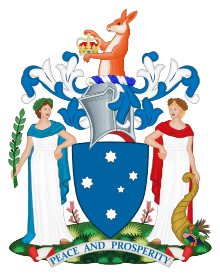
.jpg)
